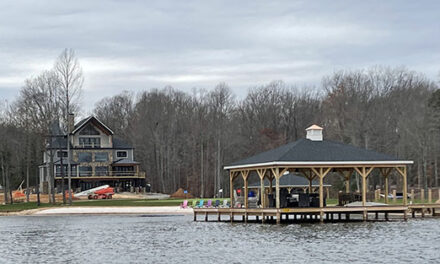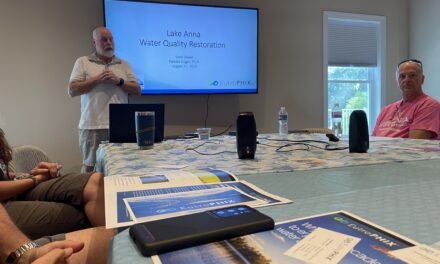Louisa County Agrees To Purchase Lake Anna Wastewater Plant
By Tammy Purcell
At its January 17 meeting the Louisa County Board of Supervisors voted unanimously to acquire an ageing wastewater treatment plant on Lake Anna with plans to modernize and upgrade it to current standards that would better enable the coming economic development of Route 208.
Louisa County agreed to pay Lake Anna Environmental Services $90,000 for the facility, which sits on about 2.5 acres just off 208 and discharges into the lake while providing wastewater service to Lake Anna Plaza businesses and adjoining townhomes.
During the meeting supervisors noted the reason for the purchase of the plant was to: 1) to provide public wastewater infrastructure for future commercial development along the 208 corridor, an area targeted for growth in the county’s 2040 Comprehensive Plan, and, 2) in the process, better protect the health of lake. Under LAES ownership, the plant has been repeatedly cited for violations by the Virginia Department of Environmental Quality.
“(Commercial property on Route 208) is going to be developed. That area is either going to be developed on private septic systems that are going to depend on developers and commercial property owners or it’s going to be developed on a wastewater treatment facility that is operated by the municipal government that’s held to the highest standards for wastewater treatment of anybody around,” said Mineral District Supervisor Duane Adams, who represents the area. “(This acquisition) is facilitating responsible infrastructure for commercial development that we all know is going to come.”
To support that development, Louisa County is considering two upgrade options for the plant, Economic Development Director Andy Wade told the Planning Commission earlier this month.
For about $7.5 million, the county could upgrade the facility from its current capacity to handle 20,000 gallons of wastewater per day to its permitted 99,000-gallon per day capacity. For about $11 million, the plant could be expanded to discharge 300,000 gallons of wastewater daily. County Administrator Christian Goodwin submitted a $7.5 million request for upgrades at the facility as part of the county’s preliminary Capital Improvement Plan for FY24.
While some community members have expressed support for the county acquiring and improving the facility—the Windwood Coves Property Owners Association submitted a letter to the board in 2021 in favor of the acquisition—the county’s proposal has turned controversial in recent months largely because of its connection to LA Resort, LLC’s plans to build a mixed-use development across the street that would connect to the infrastructure.
Despite loud opposition from neighbors, supervisors approved LAR’s request to rezone 15.2 on the south side of Route 208 for a Planned Unit Development in a separate action Tuesday night. As a proffered condition of the rezoning, LAR agreed to pay $1 million toward the facility’s upgrade and $250,000 in connection fees. LAR needs the county to purchase and upgrade the plant to support the PUD though it does have a private drain field approved on-site for a scaled-down, commercial-only site plan.
The county’s acquisition of the plant emerged as a point of contention during the rezoning with opponents arguing that buying the plant is a subsidy for wealthy developers and a risky deal for taxpayers. They questioned whether revenue from commercial development would materialize to pay for the plant and argued it’s unwise for the county to acquire an asset that’s out of compliance with state regulations.
Seven community members weighed in on the acquisition during the meeting’s public comment period with several reiterating those concerns.
But Greg Baker, president of the Lake Anna Civic Association, took a somewhat different view. He agreed that the plant has problems but said he’s open to the county stepping in to fix them.
“This privately-owned facility is wrought with issues…what’s there now is certainly broken,” Baker said. “I do hope if you vote to take over this facility you will make the necessary investments to bring this up to a standard that does not release excessive nutrients into the lake and is not something we are worried about failing.”
But Baker cautioned supervisors against expanding the plant beyond its permitted capacity. He said that LACA worked closely with DEQ to ensure that the facility wouldn’t add excess nutrients to the lake when the agency permitted it to discharge 99,000 gallons of wastewater daily. The organization opposes its expansion beyond the current limit, he said, citing concerns about the Harmful Algal Blooms that have plagued the lake north of the Route 208 bridge.
“We already have a Harmful Algae Bloom problem at Lake Anna. Harmful Algae Blooms are caused by excessive nutrients like phosphorous and nitrogen. Well, guess what comes out of wastewater treatment facilities? Nitrogen and phosphorus. So, we are very concerned about the concept of any future expansion beyond what DEQ has already approved at 99,000 gallons,” he said.
Before motioning to buy the facility, Jackson District Supervisor Toni Williams, one of the board’s most fiscally conservative members, said that most of the opposition to the facility’s acquisition relates to the rezoning not the plant itself. He said that the county’s investment would fix the issues that neighbors are complaining about, noting the current owner’s financial struggles and inability to abide by state rules. Williams also insisted that the county isn’t sure how much they’ll spend on the plant beyond fixing its current issues.
“This is a solution to a problem and, if there was not a resort tied to this, there would be no discussion. You’d be cheering not going boo,” he said. “We are fixing an existing problem that is putting pollutants into the lake.”
After agreeing to buy the plant and approving LA Resort’s rezoning, supervisors green-lighted a revised Memorandum of Understanding with LAR that obligates the developer to pay $1 million towards the plant’s upgrade. In the MOU, the county agrees to upgrade the facility to at least its permitted capacity.




















